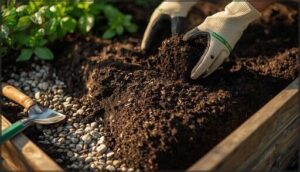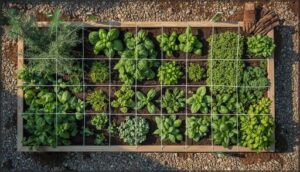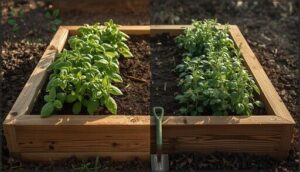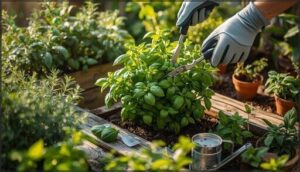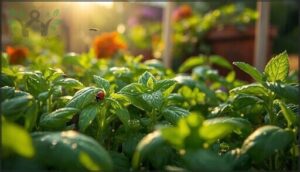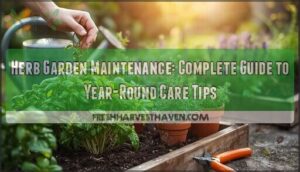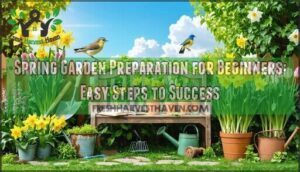This site is supported by our readers. We may earn a commission, at no cost to you, if you purchase through links.
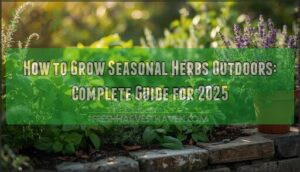
Most gardeners who venture into growing seasonal herbs outdoors make the same rookie mistake: they treat basil, cilantro, and thyme as if they’re all cut from the same cloth. The truth? Your summer sage craves blistering heat while your spring chervil throws a fit when temperatures climb past 70°F.
This temperature sensitivity isn’t just botanical trivia—it’s the difference between harvesting armfuls of fragrant leaves and watching your plants sulk through the wrong season. The secret to a thriving outdoor herb garden lies in matching each variety to its ideal growing window, then orchestrating your plantings like a conductor leading different sections of an orchestra.
When you align your herbs with nature’s rhythm rather than fighting it, you’ll access harvests that keep your kitchen stocked from the last frost of spring straight through to autumn’s final days.
Table Of Contents
- Key Takeaways
- Essential Requirements for Outdoor Herb Gardening
- Preparing Soil for Seasonal Herbs
- Choosing and Planting Seasonal Herb Varieties
- Designing an Outdoor Herb Garden
- Seasonal Care and Maintenance Tips
- Natural Pest and Disease Management
- Harvesting and Preserving Outdoor Herbs
- Frequently Asked Questions (FAQs)
- Conclusion
Key Takeaways
- Temperature-match your herbs to their ideal growing windows (summer herbs like basil need heat above 70°F while spring varieties like chervil bolt in those same conditions) to unlock continuous harvests from spring’s last frost through autumn.
- Focus on the three non-negotiables—six hours of direct sunlight daily, well-draining soil with pH between 6.0-7.5, and strategic site selection near your kitchen—since these fundamentals determine whether your herbs thrive or merely survive.
- Time your harvests for early morning after dew dries but before midday heat, cutting up to 75% of current growth above leaf nodes to preserve essential oils while triggering bushier regrowth for sustained production.
- Skip chemical interventions by using companion planting (basil near tomatoes stops aphids), organic controls like neem oil, and proper spacing for airflow, which cuts fungal infections by 60% while attracting beneficial insects naturally.
Essential Requirements for Outdoor Herb Gardening
Growing herbs outdoors isn’t rocket science, but you can’t just toss seeds in the dirt and hope for the best. Your herbs need three non-negotiables to thrive: the right amount of sunlight, soil that drains well with the correct pH, and a garden spot that sets them up for success.
Let’s break down what you need to get your outdoor herb garden off to a strong start.
Sunlight and Temperature Needs
Most outdoor herbs demand six full hours of sun daily to fuel photosynthesis rates and release bold flavors—basil, rosemary, and thyme won’t settle for less. Growing herbs outdoors means respecting their heat tolerance sweet spot: 60°F to 70°F daytime temperatures. Push beyond 85°F and you’ll watch essential oils evaporate.
Outdoor herbs need six full hours of sun and temperatures between 60°F and 70°F to develop bold flavors—beyond 85°F, essential oils evaporate
Master these sunlight requirements and temperature control basics, and your herb gardening tips transform into a thriving outdoor gardening adventure with plant care that actually delivers. Understanding the specific sunlight requirements is vital for a successful herb garden.
Ideal Soil Types and PH Levels
Your herb cultivation success depends on soil conditions that hit the right balance—loamy soil with good drainage systems beats heavy clay every time. Aim for pH levels between 6.0 and 7.5 through regular soil testing, then adjust your soil mix with organic matter like compost.
Fertility management matters less than you’d think; moderate nutrients actually boost flavor over lush growth. Understanding the importance of soil drainage systems is vital for peak herb growth.
Site Selection and Garden Planning
Beyond getting your soil right, you’ll want to scout locations that capture 6 to 8 hours of morning sun—northeast or east exposures work best for microclimate analysis and garden orientation. Check soil drainage by digging a test hole after rain; waterlogged spots spell trouble.
Position your herb garden design near the kitchen for quick harvests, sheltered from harsh winds. Yard layout matters more than you’d expect for companion planting success.
Preparing Soil for Seasonal Herbs
Getting your soil right is the difference between herbs that thrive and ones that barely survive. Most herbs need well-draining soil with the right texture and nutrients to develop those intense flavors you’re after.
Let’s break down two essential techniques that’ll transform ordinary dirt into the perfect growing medium for your seasonal herbs.
Improving Drainage With Mulch and Gravel
Clay soils suffocate herb roots, but you can break free with strategic drainage systems. Layer 10-15 cm of pea gravel beneath raised beds to create air spaces that prevent waterlogging—essential for rosemary and thyme.
Top with wood chip mulch for soil aeration and water retention balance.
This companion planting foundation transforms heavy ground into thriving herb cultivation territory, cutting evaporation by nearly 30% while your herb garden breathes.
Incorporating Compost and Organic Matter
With just a 3-4 inch compost layer mixed into the top 8-12 inches, you’ll boost microbial activity and nitrogen availability by introducing beneficial bacteria that transform soil fertility. This organic matter stabilizes pH between 6.5-7.0 while increasing water retention by nearly half a gallon per square foot—eco-friendly practices that build sustainable gardening foundations.
Annual reapplication maintains ideal soil conditions for thriving herb garden maintenance.
Choosing and Planting Seasonal Herb Varieties
Choosing the right herbs for each season transforms your garden from a one-hit wonder into a year-round powerhouse of flavor and fragrance. You’ll want to match varieties to your climate’s rhythm—some herbs thrive in spring’s cool mornings, while others laugh off summer’s scorching heat.
Let’s break down which herbs to plant when, how to get them started, and which combinations will help them flourish together.
Best Herbs for Spring, Summer, and Fall
Timing your herb gardening basics around each season’s strengths unlocks the best flavors and most vigorous growth. Climate-resilient herbs matched to spring, summer, or fall conditions thrive with less fuss and deliver abundant harvests when you work with nature’s rhythm.
- Spring herb choices: Basil, chives, coriander, dill, and lemon balm establish quickly in cool soil with ample moisture before summer heat arrives.
- Summer herb care: Oregano, rosemary, sage, thyme, and heat-tolerant basil varieties excel in warm, sunny conditions with excellent drainage.
- Fall harvest tips: Parsley, cilantro, chives, dill, oregano, and thyme planted in cooler temps resist bolting and extend your growing herbs outdoors season.
Strategic seasonal herb rotation and understanding each variety’s temperature preferences form the foundation of successful herb cultivation techniques year-round.
Starting Herbs From Seed Vs. Cuttings
Seed germination delivers genetic diversity and deep root development—your herbs adapt better to outdoor stress over time. Cutting propagation clones favorite plants, shortening harvest by weeks but demanding higher humidity and careful handling. Starting an herb garden means choosing your path: seeds cost less and build resilience, while growing herbs from cuttings preserves exact flavors you love.
| Method | Time to Harvest | Cost | Skill Level |
|---|---|---|---|
| Seeds | 8–12 weeks | Low | Beginner |
| Cuttings | 4–6 weeks | Moderate | Intermediate |
| Direct Sowing | 10–14 weeks | Very Low | Beginner |
| Division | 2–4 weeks | Low | Easy |
Herb propagation techniques reveal different advantages—match your approach to your timeline and garden goals.
Companion Planting Strategies
Companion planting strategies transform your herb garden into a self-defending ecosystem. Basil near tomatoes slashes aphid invasions, while rosemary shields carrots from flies—herb pairings deliver garden synergy that chemical sprays can’t match.
These companion planting methods improve soil while attracting beneficial insects like ladybugs and hoverflies. Strategic herb gardening tips and tricks prove pest control methods work best when nature does the heavy lifting.
Designing an Outdoor Herb Garden
Once you’ve chosen your herbs, it’s time to decide how you’ll actually grow them. Your setup matters more than you might think—it affects drainage, maintenance, and how easy it’s to harvest when you’re cooking.
Let’s look at three proven approaches that work for outdoor herb gardens, from traditional beds to creative container solutions.
Garden Bed Layouts and Spacing
Think of your herb garden as a stage where each plant needs room to shine. Rectangular beds around 4 feet wide with 12-inch string grids let you nail bed arrangements and herb grouping without the guesswork. Position taller plants center-stage, shorter ones along edges—this pathway design creates natural flow while planting herbs at proper distances.
Keep 3-foot paths between beds for outdoor gardening access and herb garden maintenance that won’t break your back.
Raised Beds Vs. Ground Beds
Your choice between raised beds and ground beds shapes everything from drainage systems to microclimate control in your outdoor garden.
Raised beds offer excellent soil elevation and bed construction flexibility—you’ll fill them with a perfect growing medium while achieving root health through better drainage and earlier spring warmth.
Ground beds work when you’ve got high-quality native soil, though they’ll demand more attention to plant care and gardening tips for managing compaction and weeds.
Growing Herbs in Containers and Steel Tubs
When you’re short on space or want total control over drainage systems, containers and steel tub gardening give you that freedom. Steel tubs retain heat beautifully, extending your growing season while keeping herbs like rosemary thriving. Just drill drainage holes every 3-4 inches, layer gravel at the bottom, and fill with peat-based container soil mixed with 25% perlite for ideal herb potting conditions.
Container gardening unleashes possibilities for your herb garden:
- Move your patio gardening setup to chase perfect sunlight throughout the day
- Control every aspect of growing herbs in containers—from moisture to nutrients
- Transform balconies into productive growing herbs outdoors zones
- Experiment boldly with space optimization techniques traditional beds can’t match
- Create your own Mediterranean microclimate through strategic container placement
Seasonal Care and Maintenance Tips
Your herbs won’t thrive on autopilot—they need consistent attention throughout the growing season to hit their full potential. The right care routine keeps plants vigorous, flavorful, and productive from spring through fall.
Let’s break down the essential maintenance practices that’ll transform your outdoor herb garden into a year-round powerhouse.
Watering and Fertilizing Practices
Consistently monitoring soil moisture transforms herb garden maintenance from guesswork into precision. Water-loving herbs like parsley thrive with soil kept moist 1-2 inches deep, while drought-tolerant rosemary demands thorough watering every 1-2 weeks, followed by complete drying.
Balance your irrigation schedules with the herbs’ natural preferences—most outdoor varieties need watering 1-2 times weekly.
For fertilizing, apply organic options like compost teas or slow-release formulas every 4-6 weeks during active growth, supporting vigorous nutrient cycling without overwhelming delicate root systems.
Pruning and Pinching Techniques
Beyond watering schedules, strategic pruning unlocks your herbs’ full potential. Grab sharp pruning tools and trim just above leaf nodes where leaves emerge—this triggers explosive lateral growth.
Pinch timing matters: snip basil every few days once it hits 6-8 inches, while woody herbs like sage wait until spring’s green shoots appear.
Regular stem cutting prevents flowering, channeling energy into lush, flavorful leaves you’ll actually harvest.
Managing Weeds and Mulch Application
After pruning comes the unglamorous battle: weeds steal nutrients faster than you’d think. Layer organic barriers like straw or wood chips 2-3 inches deep around your herb garden—this weed suppression tactic blocks light while moderating soil temperature swings. Outdoor gardening rewards the vigilant.
Your mulch strategy transforms soil conditions:
- Retain twice the moisture without constant watering
- Choke out 60% of competing weeds naturally
- Feed your growing herbs as organic mulch decomposes
Natural Pest and Disease Management
You don’t need to reach for chemical sprays every time a pest shows up in your herb garden. There’s a whole toolkit of natural strategies that keep your plants healthy without compromising the flavor or safety of what you’re growing.
Let’s walk through how to spot trouble early, handle it organically, and stop problems before they start.
Identifying Common Herb Pests
Dealing with herb pests starts with knowing your enemy. You’ll spot aphids as tiny, soft-bodied insects clustering on stems—they’re less than 1/8 inch long but multiply fast, producing up to 200 young in just 7–10 days. Look for sticky honeydew residue and yellowing leaves on your basil or mint. Spider mites leave telltale webbing and stippled foliage, while whiteflies create cloud-like swarms when disturbed.
Check leaf undersides during your morning inspection—that’s where most herb pests hide. Caterpillars leave obvious damage with large holes or completely stripped stems, plus distinctive black droppings. Four-lined plant bugs create yellow spots that turn brown, though they’re tricky to catch since they move quickly.
| Pest | Key Identification Signs |
|---|---|
| Aphids | Sticky honeydew, curled yellow leaves, small soft bodies under 1/8″ |
| Spider Mites | Fine webbing, yellow stippling, reddish discolored leaves |
| Caterpillars | Large chewed holes, black pellet droppings, missing leaf sections |
| Whiteflies | White moth-like clouds when disturbed, yellowing leaves, honeydew |
Early bug identification means you can tackle problems before your harvest suffers, keeping your herb garden thriving without reaching for harsh chemicals.
Organic Pest Control Solutions
When herb pests strike, you’ve got powerful organic pest control allies ready to defend your garden. Natural repellents like neem oil disrupt feeding cycles of aphids and spider mites, while companion planting creates living pest deterrents—basil near tomatoes reduces infestations naturally.
Three biocontrol methods for organic gardening:
- Neem oil uses: Apply weekly as an organic spray against whiteflies and scale insects
- Spinosad treatments: Target caterpillars and thrips without harming beneficial insects
- Companion herbs: Plant rosemary and lavender as natural repellents for pest management
Preventing and Treating Diseases
Vigilance is your strongest defense against herb plant diseases. Start with sanitation—promptly remove infected leaves and sterilize tools to slash cross-contamination by 85%. Disease resistance matters: choose mildew-resistant basil varieties to cut fungicide needs by 30%. For fungal control, organic treatments like oregano oil and baking soda sprays alter leaf pH, stopping spores cold.
| Prevention Strategy | Disease Impact Reduction |
|---|---|
| Proper spacing/airflow | 60% lower fungal growth |
| Early morning watering | 50% fewer infections |
| Crop rotation practice | Eliminates soilborne buildup |
Smart soil conditions and pest management protect your harvest herbs year-round.
Harvesting and Preserving Outdoor Herbs
You’ve done the hard work of growing your herbs—now comes the payoff. Knowing when to harvest and how to preserve your bounty means you’ll have fresh flavor at your fingertips long after the growing season ends.
Let’s walk through the timing, techniques, and storage methods that’ll keep your herbs potent and ready to use.
Best Times and Methods for Harvesting
Harvest timing dramatically impacts flavor preservation and peak yield. Grab your harvest tools early in the morning after dew dries but before midday heat strikes.
Harvesting herbs properly means cutting up to 75% of current growth using sharp clippers angled above leaf nodes. This herb pruning and harvesting technique maintains leaf quality while encouraging bushier regrowth, giving you continuous harvests all season long.
Drying, Freezing, and Storing Herbs
Locking in flavor after you harvest herbs demands the right preservation approach. Choose drying methods like hanging bundles in shade or using a dehydrator at 70°C for faster results, while freezing techniques—like chopping herbs into oil-filled ice cube trays—preserve potency for cooked dishes.
Smart herb storage means cool, dark spots (15–21°C) in opaque containers, and these preservation tips keep your harvest vibrant for months.
Key harvesting and preserving herbs strategies:
- Dry basil in direct sun for moisture reduction to 10% within 6 hours
- Freeze herbs at 0°F in airtight containers to slow degradation
- Store dried herbs away from UV light to prevent potency loss
- Use frozen herbs within 3–6 months for peak quality
Extending The Herb Harvest Through The Year
Stretching your outdoor herb harvest beyond summer means thinking like a strategist. Low tunnels—3 feet wide, plastic-draped hoops—create microclimates that shelter sage and parsley through Zone 5b winters, while succession planting basil every two weeks prevents shortages.
Cold climate gardeners can layer 2-6 inches of mulch over hardy thyme and oregano, turning season extension into year-round harvesting reality with minimal fuss.
Frequently Asked Questions (FAQs)
Can herbs survive frost or cold snaps?
Here’s the truth: some herbs laugh in the face of frost while others fold at the first freeze.
Cold-hardy perennials like thyme, rosemary, and sage demonstrate impressive frost tolerance, surviving temperatures well below freezing.
How often should herb gardens be rotated?
You’ll want to rotate your herb garden every 3 to 4 years to break pest cycles and support soil rejuvenation.
This garden renewal practice maintains plant diversity and keeps your outdoor growing space thriving season after season.
What herbs attract the most beneficial insects?
Your herb garden becomes a five-star restaurant for ladybugs when you let cilantro, dill, fennel, and yarrow flower.
These pollinator herbs and beneficial flowers transform outdoor gardening into thriving garden biodiversity through strategic insect attractants and herb ecology principles.
Should herbs be fertilized before winter dormancy?
Skip fertilizing herbs as winter dormancy approaches. Late-season fertilizer timing encourages vulnerable new growth that frost will damage.
Instead, focus your seasonal herb care on cold protection and natural overwintering. Your herb garden maintenance strategy should prioritize survival over forced growth.
How do you revive leggy or overgrown herbs?
Like a haircut that brings new life to tired locks, aggressive pruning transforms leggy herbs.
Cut stems back to healthy leaves, relocate to brighter spots, and apply balanced fertilizer to stimulate compact, vigorous regrowth.
Conclusion
Sure, you could keep buying wilted supermarket herbs wrapped in plastic while your backyard sits empty—perfectly logical if you enjoy paying premium prices for mediocre flavor.
Or you could rebel against that nonsense by growing seasonal herbs outdoors, syncing your plantings with nature’s actual calendar instead of corporate supply chains. Match your varieties to their preferred temperatures, prep your soil properly, and suddenly you’re the one with year-round harvests that make store-bought sprigs look like the joke they’re.
- https://extension.uga.edu/publications/detail.html?number=B1170&title=Herbs%20in%20Southern%20Gardens
- https://hgic.clemson.edu/factsheet/herbs/
- https://digitalpubs.ext.vt.edu/vcedigitalpubs/6992314651966782/MobilePagedReplica.action?pm=1&folio=1
- https://www.instagram.com/beautifuleatsandthings/
- https://extension.wvu.edu/lawn-gardening-pests/gardening/gardening-101/herb-gardening-for-beginners

